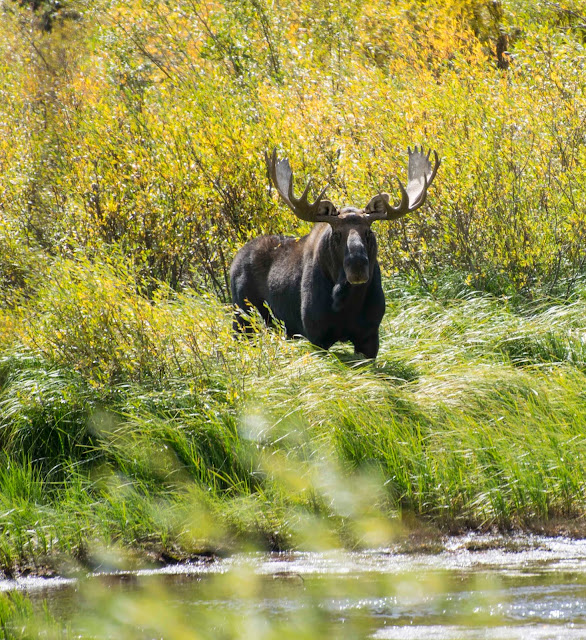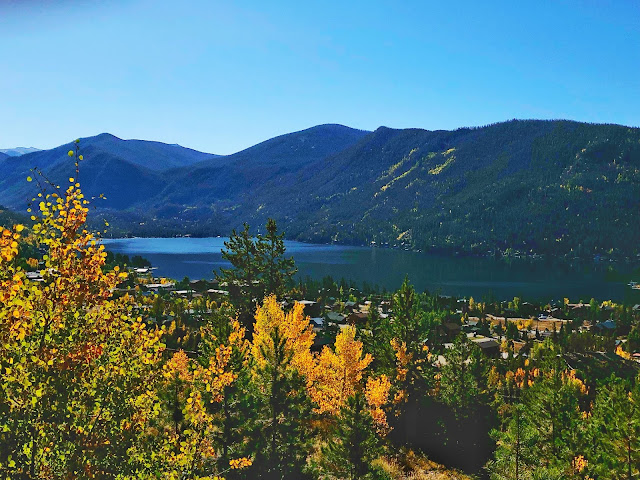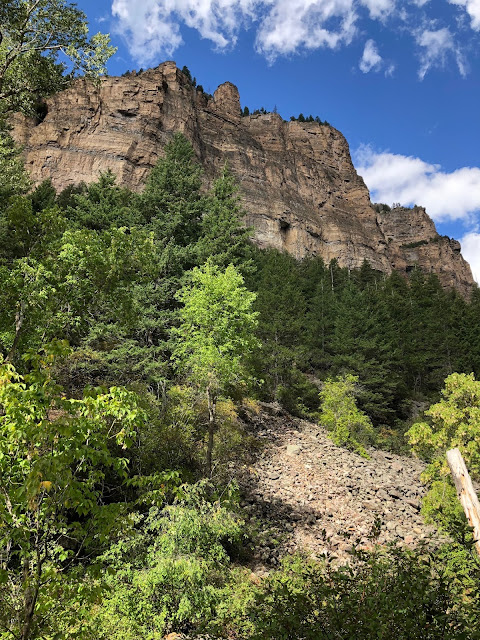On Friday, Sept. 27th, we awoke to a rainstorm, so we hung around the Inn until afternoon doing some errands and more long-range planning for our adventure. The rain let up just long enough for us to take a short hike on a small trail behind the hotel. Then we drove thirty miles to Grand Lake, CO, to take a hike in the town's recreation area where we found there a been a recent forest fire and the trail was not in very good shape. Just as we got out of the car it started to pour again, so we returned to Rocky Mountain National Park hoping to see more Elk or Moose.
We only found a single Bull Elk and one cow right in the Timber Creek Campground with several people getting much too close, risking being attacked by the bull elk.
On Saturday, Sept. 28th we drove ten miles back to the end of Granby Lake to the Arapaho National Forest where we found the seven-mile-long Doe Creek Trail, a dog-friendly hike that winds around a mountain overlooking the Westside of Granby Lake. The Fall foliage was beautiful and we very much enjoyed the long hike. The only thing missing was that we didn't encounter any wildlife on our adventure.
The Aspen trees (vivid yellow leaves) in particular added brilliance to the otherwise green conifers creating a nice kaleidoscope of color to the mountain trail.
Aspen trees are interesting in that they shed their lower branches as they grow taller leaving dark scares where the branches were, as the higher branches seek sunlight. They also have the distinction of being the first trees to reroot themselves after a forest fire, leading the way for regrowth conifers to get started on the cycle of reforestation.
We saw evidence of forest fire damage and insect infestation as well along the trail. Much of the western forests have been invaded by insects that kill pine trees, so there are many places with dead and dying pine forests which increase the chances of forest fires because of the increase of available fuel to feed the fire once it starts (often from lightning strikes).
A Male Elk produces a very unique sound when trying to attract females during their mating season. The sound is a haunting, shrill, sound called bulging.
We saw evidence of forest fire damage and insect infestation as well along the trail. Much of the western forests have been invaded by insects that kill pine trees, so there are many places with dead and dying pine forests which increase the chances of forest fires because of the increase of available fuel to feed the fire once it starts (often from lightning strikes).
The view of Granby Lake from the top of the mountain was awe-inspiring.
In the late afternoon, Mom and Dad left me at the Inn to take a nap and drove back to Rocky Mountain NP to spend some more time hiking and try to find some more Elk herds.
They tried the Coyote Valley trail in the center of the river valley first but found no wildlife there.
Just before dark they were successful and discovered a huge Bull Elk with his harem of over 22 females not far from the Timber Lake Campground in the park.
Other males stay just outside of the range of the harem and try to entice females to leave the harem and come with them by using that same mating sound to gather their own harem.
The bigger males will challenge the intruder males, sometimes engaging in combat using their antlers and feet as weapons. Sometimes the contest gets so intense one of the combatants does not survive. Sorry, the sound portion of this picture does not work properly.

Tomorrow we will get ready to move on and say goodbye to Rocky Mountain National Park😀.






















































